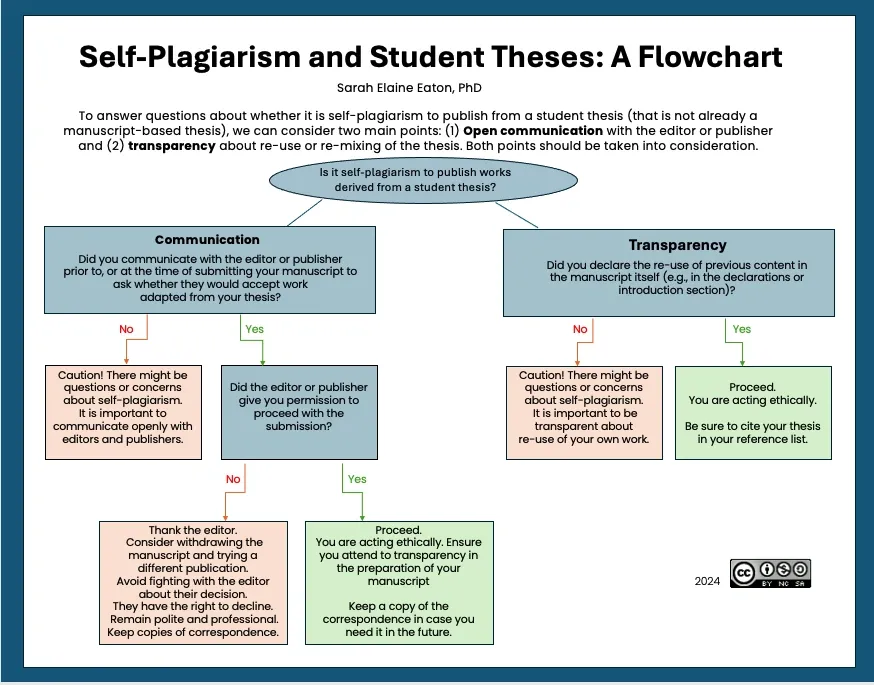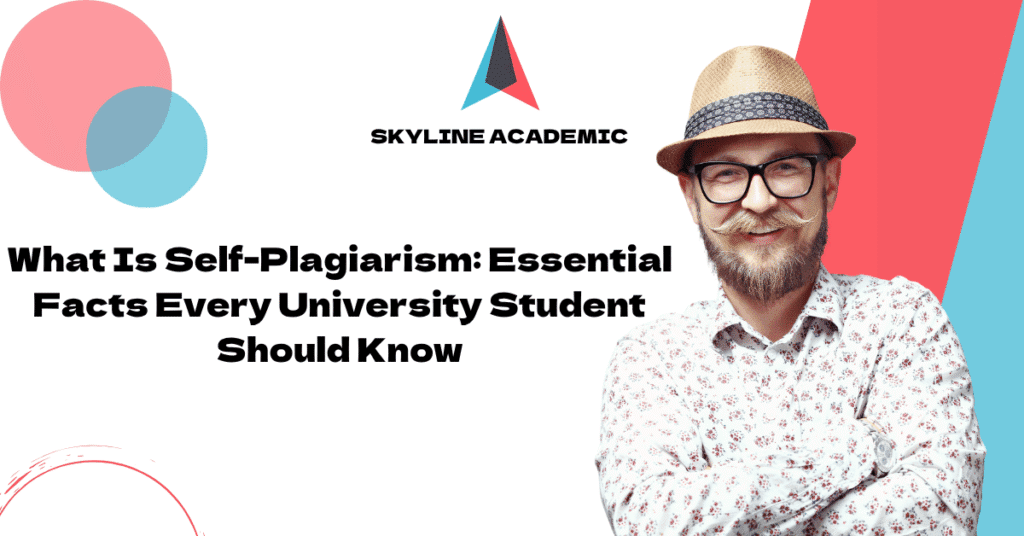What Is Self-Plagiarism: 6 Essential Facts Every University Student Should Know
Are you clear about what self-plagiarism means and why it matters to you as a university student? Most students know that plagiarism means using someone else’s work without giving credit . Self-plagiarism often goes unnoticed. The federal regulations don’t label self-plagiarism as research misconduct , but it can still lead to serious academic problems.
When someone uses another person’s work without credit, that’s plagiarism . Self-plagiarism happens when you reuse your own submitted work without citing it. You can avoid plagiarism by learning the right way to quote, paraphrase, and format citations . These rules apply to your previous work as well.
This piece will help you understand the key differences between regular plagiarism and self-plagiarism. You’ll see common examples from academic life and learn practical ways to keep your work honest. On top of that, you’ll find simple techniques to avoid plagiarism in your research and academic writing that will protect you from accidental academic dishonesty.
What is self-plagiarism and how is it different from plagiarism?

Image Source: Learning, Teaching and Leadership
Self-plagiarism creates a unique ethical challenge in academic writing that students often struggle to grasp. Traditional plagiarism involves using someone else’s work without permission, but self-plagiarism brings its own set of challenges and misunderstandings.
Definition of self-plagiarism
You commit self-plagiarism when you reuse your previously published or submitted work without proper citation. The practice involves recycling your previous content and passing it off as new work [1]. This could mean submitting the same paper twice, copying parts from your old assignments, or using data from previous research without attribution.
Merriam-Webster says self-plagiarism happens when someone reuses “one’s own words, ideas, or artistic expression from preexisting material especially without acknowledgment of their earlier use” [2]. This shows that the biggest problem isn’t about who owns the work – it’s about being honest about where the content came from.
How it is different from traditional plagiarism
The key distinction between traditional and self-plagiarism comes down to authorship. Traditional plagiarism happens when someone takes another person’s ideas or words and claims them as their own – a clear case of intellectual theft and academic dishonesty [3].
Self-plagiarism doesn’t steal from others since you’re using your own work. In spite of that, it still counts as academic dishonesty because you present old work as new [4]. Plus, publishing in a journal means you give your rights to the publisher, which can lead to copyright infringement if you reuse that work elsewhere [1].
Why students often overlook it
Students miss self-plagiarism for several reasons. They often think you can’t “steal from yourself” [3]. The logic goes: if you wrote it first, why can’t you use it again?
Academic integrity means different things around the world. While anti-plagiarism rules are becoming more common globally, some places don’t see self-plagiarism as a problem [2].
Students also don’t always understand copyright rules. Once your work gets published, you might not own the rights to it anymore [5]. Using large chunks of it without permission could break copyright law.
Many students don’t realize that turning in one assignment for multiple classes breaks academic integrity rules [6]. They see it as smart time management rather than cheating.
Your academic reputation matters. Always cite your previous work when you reuse it and check with professors before using assignments across different courses.
Common types of self-plagiarism in academic settings

Image Source: Academic Integrity Hub – University of Regina
Students often commit self-plagiarism without knowing its risks. You can protect your academic integrity by learning about common types of self-plagiarism during your academic experience.
Reusing previous assignments
Students commonly self-plagiarize by taking an old paper and submitting it for a new class [4]. This shows you’re not interested in creating fresh work and defeats the purpose of your current course. Most schools don’t allow this in their academic integrity rules. You need written permission first if you want to use similar work in different courses [7].
Duplicate submissions across courses
Using the same or slightly changed work in multiple courses at once is also self-plagiarism. This breaks academic integrity rules because you trick professors by using one assignment to meet requirements for different courses [8]. The risks are serious – you could face consequences like failing grades, academic probation, or even getting kicked out of school [9].
Text recycling in research papers
Text recycling happens when you reuse parts of your published work in new papers. Research shows these main types:
- Developmental recycling: Reusing unpublished materials (generally acceptable)
- Generative recycling: Reusing parts of published work in new contributions
- Duplicate/redundant publication: Republishing old work with small changes [10]
A 2020 study found about three recycled sentences in each published article. Only 15% of research groups recycled much of their text [10].
Improper paraphrasing of your own work
Students try to hide self-plagiarism by making small changes – swapping words or moving sentences around. These tiny tweaks don’t fix the academic honesty problem [11]. Such basic changes can make your work worse and harder to read [10].
The right way is to cite properly and be open with your teachers. Get permission before reusing your work and cite your old papers correctly, just like any other source.
Why self-plagiarism is a serious academic issue
Self-plagiarism goes beyond just breaking rules – it has serious implications that many academic institutions see as a major breach of trust in educational communities.
Violation of academic integrity policies
Academic honesty principles are the foundations of educational institutions, and self-plagiarism breaks these principles at their core. A study shows that 80% of faculty members would fail students who don’t cite their previous work [12]. In fact, this practice tricks readers by passing off old work as new original content [12]. The problem runs deep – research shows that 60% of students and faculty members don’t fully grasp what self-plagiarism means [13].
Impact on originality and learning
Education’s main goal is to develop new skills through original work. Students who reuse their work go against this basic principle. When someone recycles old assignments, it shows they’re not interested in creating new ideas [14] and reduces both their academic growth and the institution’s value. Submitting duplicate work also suggests an attempt to get ahead without doing the required work [15].
Consequences from universities and journals
Universities don’t take self-plagiarism lightly – they treat it just like regular plagiarism [16]. Penalties can include:
- Zero grades on assignments
- Course failure
- Academic probation
- Suspension or expulsion [16]
Publishers retract one in every five papers due to self-plagiarism [17], which hurts the author’s academic reputation. Research shows that authors with retractions see their citation rates drop by 10-20% [18]. The practice ended up causing legal issues too, as it can break publisher copyright agreements [12].
How to avoid self-plagiarism in your writing
Your academic reputation depends on preventing self-plagiarism. Students need awareness and proactive strategies to protect their work.
Understand your institution’s policies
You should know your university’s specific guidelines about self-plagiarism. Academic institutions define self-plagiarism as “submitting an assignment for credit that has already been submitted, unless the current instructor authorizes its use prior to submission” [19]. Your course syllabi might have additional department-specific requirements you need to follow.
Always cite your previous work when reused
You must cite yourself just like any other source when using previously published material [4]. Proper attribution is essential even for partial reuse of your work. “Instead of repeating what you’ve already stated in another manuscript, just reference your previous work” [5].
Use plagiarism checkers to detect overlaps
Specialized software helps identify potential self-plagiarism problems. Regular plagiarism checkers can’t detect self-plagiarism in institutional databases [4]. Tools like Scribbr’s Self-Plagiarism Checker let you compare your previous assignments effectively [20].
Consult your professor before reusing content
Your current instructor must give explicit permission before you reuse previous work [21]. This step helps avoid academic integrity violations. Being transparent with faculty members protects your academic standing.
Practice proper paraphrasing techniques
The best way to paraphrase your own work is to “read the passage, look away, think about it for a moment; then, still looking away, paraphrase it in your own words” [22]. This approach leads to genuine reformulation rather than simple word substitution.
Use citation tools to manage references
Reference management software like Zotero, EndNote, or Mendeley makes source organization easier [23]. These tools create citations and bibliographies in various styles automatically. They save time and ensure consistency.
Skyline’s academic resources offer tools and guides that help prevent self-plagiarism. Students can access our citation management tools and plagiarism checkers to maintain academic integrity.
Conclusion
Self-plagiarism remains one of the most important yet misunderstood parts of academic integrity. This piece explains how recycling your own work without proper attribution can have serious consequences. Students might face course failure, academic probation, and damage to their professional reputation. You might think it’s impossible to “steal from yourself,” but academic institutions consider self-plagiarism as dishonesty because it presents old work as new.
Students should make avoiding self-plagiarism a key part of their academic practice. You need to know your institution’s specific policies about reusing your own work. Make sure to cite yourself just as you would cite any other source. The best practice is to check with your professors before you reuse assignments across courses.
Reliable plagiarism detection tools help identify possible overlaps with your previous work. Skyline’s academic resources offer detailed tutorials, citation tools, and plagiarism detection software to support your academic writing. These resources will guide you to prevent self-plagiarism effectively.
Academic integrity needs constant watchfulness and awareness. Original work for each assignment protects your academic standing and enhances your learning experience. Education’s main goal is to develop new skills and knowledge through real involvement with course material. Recycling old work won’t achieve this goal. Your steadfast dedication to academic honesty today will build the foundation for ethical professional practices tomorrow.
FAQs
Q1. What exactly is self-plagiarism in academic settings?
Self-plagiarism occurs when you reuse your own previously submitted or published work without proper citation or acknowledgment. This includes resubmitting entire papers, copying sections from previous assignments, or reusing data from earlier research without appropriate attribution.
Q2. How does self-plagiarism differ from traditional plagiarism?
While traditional plagiarism involves using someone else’s work without proper credit, self-plagiarism involves recycling your own previous work. Both are considered forms of academic dishonesty, but self-plagiarism doesn’t involve theft from others. Instead, it misrepresents previously submitted work as new.
Q3. What are the consequences of self-plagiarism in universities?
Universities often treat self-plagiarism as seriously as traditional plagiarism. Consequences can range from receiving a zero grade on the assignment to course failure, academic probation, or even suspension or expulsion in severe cases.
Q4. How can students avoid self-plagiarism in their academic work?
To avoid self-plagiarism, always cite your previous work when reusing it, consult with your professors before repurposing assignments across courses, use plagiarism checkers to detect overlaps, and practice proper paraphrasing techniques. It’s also crucial to understand your institution’s specific policies on self-plagiarism.
Q5. Is it possible to use my previous work in a new assignment?
Yes, but you must do so ethically. Always obtain explicit permission from your current instructor before reusing your previous work. If approved, make sure to cite your previous paper appropriately, just as you would any other source. This ensures transparency and maintains academic integrity.
References
[1] – https://guides.library.unt.edu/plagiarism/self
[2] – https://www.turnitin.com/blog/self-plagiarism-definition-can-you-plagiarize-yourself-using-ai
[3] – https://www.enago.com/plagiarism-checker/resources/difference-between-plagiarism-and-self-plagiarism
[4] – https://www.scribbr.com/plagiarism/self-plagiarism/
[5] – https://www.aje.com/arc/self-plagiarism-how-to-define-it-and-why-to-avoid-it/
[6] – https://communitystandards.stanford.edu/policies-guidance/honor-code/common-misconceptions
[7] – https://extension.harvard.edu/enrolled-students/academic-integrity/
[8] – https://www.bowdoin.edu/dean-of-students/conduct-review-board/academic-honesty-and-plagiarism/common-types-of-plagiarism.html
[9] – https://www.manuscriptedit.com/scholar-hangout/the-impact-of-duplicate-submission-protecting-your-academic-and-professional-reputation/
[10] – https://asm.org/articles/2022/april/let-s-rethink-text-recycling
[11] – https://academic.oup.com/bioscience/article/73/1/6/6760206
[12] – https://www.turnitin.com/blog/what-is-self-plagiarism-and-what-does-it-have-to-do-with-academic-integrity
[13] – https://www.duffylawct.com/problem-self-plagiarism-college-courses/
[14] – https://crossplag.com/what-is-self-plagiarism/
[15] – https://oai.missouri.edu/students/self-plagiarism/
[16] – https://studentdefense.kjk.com/2024/09/04/understanding-self-plagiarism/
[17] – https://www.tandfonline.com/doi/full/10.1080/08989621.2025.2472016
[18] – https://www.turnitin.com/blog/what-is-the-impact-of-self-plagiarism-for-researchers
[19] – https://honesty.uga.edu/academic-honesty-policy/prohibited-conduct/
[20] – https://www.scribbr.com/plagiarism-checker/
[21] – https://apastyle.apa.org/style-grammar-guidelines/citations/plagiarism
[22] – https://honor.virginia.edu/understanding-fraud
[23] – https://laneguides.stanford.edu/reference-management



